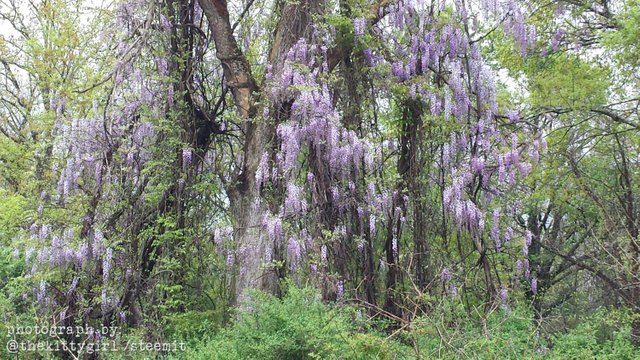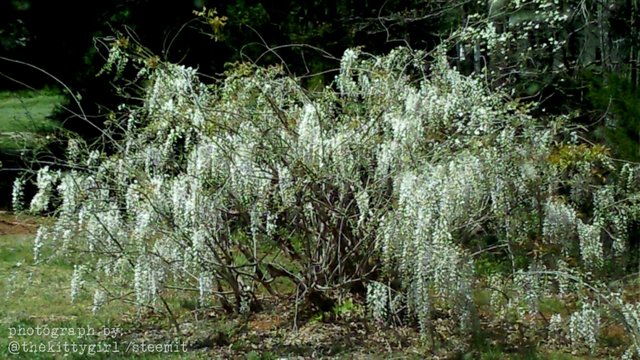Wisteria

• PHOTO BY ME, CHINESE WISTERIA IN OUR YARD •
W. floribunda (Japanese wisteria) twines clockwise when viewed from above, while W. sinensis twines counterclockwise when viewed from above. [2]
Based on the above information, the Wisteria in our yard is Chinese Wisteria (Wisteria sinensis), since it curls in a counterclockwise direction. I remember when I was a child, my father planted some Wisteria for my mother. He tended to it very carefully and let it twine up a wooden stave. Keeping it pruned as it grew, it finally took on the semblance of a tree, and the blooms were so pretty. He hated the mess which the flowers made on the lawn as the petals dropped, and frequent pruning was necessary to keep the vines in-check, but he did it, lovingly, for my mother's enjoyment.
The flowers smell sweet and the fragrance permeates the air nearby when they are blooming. The only downside to the Asian varieties is that they are rapidly-growing, prolific vines that are very difficult to control. I have spent hours — literally — pruning, cutting, and pulling Wisteria vines out of trees and bushes, and it is not fun. A couple of miles from the house, there is a spot where Wisteria has grown, unchecked, in that manner and it makes a stunning display in the springtime:

• PHOTO BY ME • to view larger image, click here

• PHOTO BY ME •
 😊
😊SOURCES
1 GardeningKnowHow.com: American Wisteria
2 Wikipedia: Wisteria
3 Wikipedia: Wisteria floribunda
4 Wikipedia: Wisteria frutescens
5 Wikipedia: Wisteria sinensis






BEAUTIFUL images!
We don't have any Wisteria around me, but it is such a delicate and glorious looking tree.
Hi this is bot belongs to @sapphic
You are obviously on her author upvote whitelist, (which means you are pretty special), or your post passed the threshold of her algorithm.
Either way she will be along shortly to read your post, ponder it and leave a lovely comment.
Thank you for another interesting post, @thekittygirl.
When I was a child, I thought the purple-flowered vine in the tree in our yard in Darlington County was a mysterious vine.
It seems that they were a more common decorative plant in the South a few decades ago. I wonder if that is just my faulty memory?
Since the Chinese Wisteria and Japanese Wisteria grow out of control so easily, I suspect that some folks make a conscious decision to keep it off their property. My father decided to do exactly that a few years ago, but we were unable to remove all the roots, so it keeps coming back.
There appear to be gardening "fads" that come-and-go with time. Seeds are shared, or there is a merely a desire to plant what others are planting (either to "keep up with the Joneses" or to try to out-best the Jones' garden). I remember my mother planted many things when I was a child simply because people in the neighborhood/church shared seeds with her, and she shared seeds from her plants with others. Perhaps Wisteria is "out of style" for now, but will be coming back in vogue at some other time?
Since the non-native Chinese Wisteria and Japanese Wisteria are so prolific, they are considered to be "invasive species" in many areas, so gardeners are encouraged to plant the native American Wisteria instead. That variety requires more moisture, though, and the blooms are not as large, nor quite as fragrant, so many gardeners might be abandoning the idea of Wisteria, altogether. That is merely a guess, though, from what I have read and I don't have any data to back that theory.
Thanks for your comment! 😊
Hello @thekittygirl !
Very nice post ! I love flowers, and I learnt many things on your post.
Greetings.
Beem writing about flowers too now and then... This is beautiful, i love them though Idont see Wisteria often here I dream of a lilac photoshoot one day.
I woukd love to see lilacs some day, too! We don't have them here, as it is too far south for them to thrive. I hope you get a chance to photograph them sometime! 😊
Thank you for the resteem! 😊
Oooo. Those are pretty! They really get covered in a lot of blooms.
Wow! I haven't seen wisteria around or anything similar here in my place. Lovely!
#steemitbloggers